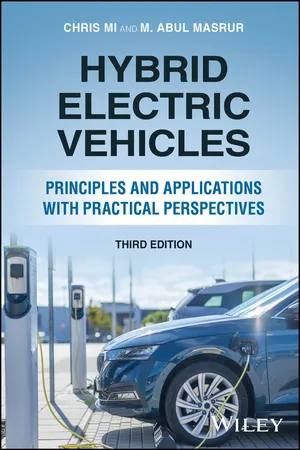
Hybrid Electric Vehicles
Principles and Applications with Practical Perspectives
- 573 pages
- English
- PDF
- Available on iOS & Android
Hybrid Electric Vehicles
Principles and Applications with Practical Perspectives
About this book
Introduction to all types of hybrid electric vehicles (HEVs), with coverage of fundamentals, applications, and the latest industry technologies
Hybrid Electric Vehicles: Principles and Applications with Practical Perspectives provides an introduction to hybrid vehicles, from hybrid-electric, hybrid-hydraulic, and plug-in hybrid-electric vehicles to fuel-cell vehicles and off-road hybrid vehicular systems. The book focuses on the propulsion systems for these vehicles, including issues related to power and energy management. Other topics covered include hybrid vs. pure electric, hybrid electric vehicle (HEV) system architecture (including plug-in, charging control, and hydraulic), safety and EMC, storage technologies, vehicular power and energy management, diagnostics and prognostics, and electromechanical vibration issues.
This Third Edition has been updated to address the latest industry trends and technologies impacting HEVs, such as more detailed discussions on planetary gear, synchronous reluctance motors, fast-charging methods for batteries, and matters pertaining to cybersecurity in vehicles. The latest HEV industry data and examples highlighting automakers' current HEV models are featured throughout the book.
Topics discussed in Hybrid Electric Vehicles: Principles and Applications with Practical Perspectives include:
- Specific state-of-the-art HEVs including the Toyota Prius, the Honda Civic, and the Ford Escape, with additional coverage of two-mode hybrid vehicles
- HEV fundamentals, covering performance, powertrain component sizing, gradability requirements, and selection of gear ratios
- Cold start emissions reduction and cold/hot weather performance enhancement
- Electric and hybrid ships, aircraft, and locomotives, with discussion on industrial utilization of other types of vehicles
- Military applications of HEVs, covering ruggedness issues, dismounted soldier applications, and electromagnetic launchers
- Fast charging of batteries in electrified vehicles
- Cybersecurity issues in electrified vehicles
Hybrid Electric Vehicles: Principles and Applications with Practical Perspectives is an essential up-to-date reference on the subject for engineers working in the automotive industry, including at automakers, vehicle OEMs, and component suppliers, as well as students and instructors in upper-level undergraduate or graduate courses related to HEVs and electric propulsion.
Frequently asked questions
- Essential is ideal for learners and professionals who enjoy exploring a wide range of subjects. Access the Essential Library with 800,000+ trusted titles and best-sellers across business, personal growth, and the humanities. Includes unlimited reading time and Standard Read Aloud voice.
- Complete: Perfect for advanced learners and researchers needing full, unrestricted access. Unlock 1.4M+ books across hundreds of subjects, including academic and specialized titles. The Complete Plan also includes advanced features like Premium Read Aloud and Research Assistant.
Please note we cannot support devices running on iOS 13 and Android 7 or earlier. Learn more about using the app.
Information
Table of contents
- Cover
- Title Page
- Copyright
- Contents
- About the Authors
- Preface to the First Edition
- Preface to the Second Edition
- Preface to the Third Edition
- Chapter 1 Introduction
- Chapter 2 Concept of Hybridization of the Automobile
- Chapter 3 HEV Fundamentals
- Chapter 4 Advanced HEV Architectures and Dynamics of HEV Powertrain
- Chapter 5 Plug‐in Hybrid Electric Vehicles
- Chapter 6 Special Hybrid Vehicles
- Chapter 7 HEV Applications for Military Vehicles
- Chapter 8 Diagnostics, Prognostics, Reliability, EMC, and Other Topics Related to HEVs
- Chapter 9 Power Electronics in HEVs
- Chapter 10 Electric Machines and Drives in HEVs
- Chapter 11 Electric Energy Sources and Storage Devices
- Chapter 12 Battery Modeling
- Chapter 13 EV and PHEV Battery Charger Design1
- Chapter 14 Modeling and Simulation of Electric and Hybrid Vehicles*
- Chapter 15 HEV Component Sizing and Design Optimization
- Chapter 16 Wireless Power Transfer for Electric Vehicle Applications
- Chapter 17 Vehicular Power Control Strategy and Energy Management
- Chapter 18 Commercialization and Standardization of HEV Technology and Future Transportation
- Chapter 19 A Holistic Perspective on Vehicle Electrification
- Index
- EULA